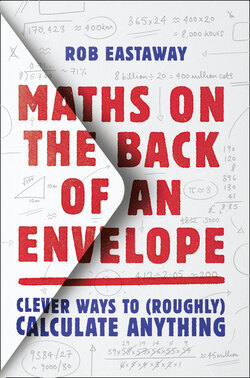Читать книгу Maths on the Back of an Envelope - Rob Eastaway - Страница 9
DRESSING UP NUMBERS WITH DRESSAGE
ОглавлениеIn 2012 London hosted the Olympics. People throughout Britain celebrated as gold medallists stepped up on the podium in all sorts of sports in which previous GB athletes had rarely excelled.
There was particular joy when Charlotte Dujardin, who had worked her way up from being a stable girl to becoming an elite equestrian, claimed Britain’s first ever gold medal with her horse Valegro in the dressage event.
Dujardin’s winning score from the judges was an impressive 90.089%.
Sportspeople often talk about ‘giving it that extra ten per cent’, but in this case it seemed as if Dujardin had fine-tuned this, so she could put in that extra 10.001%. What was it that made her performance better than somebody who got, say, 90.088% instead?
To understand where her three-decimal-place score came from, we need to look at how the judges allocated marks in that competition.
In the dressage event at the London Olympics, the competitors were required to take their horse through a series of movements, which would be assessed by seven judges seated around the arena so they could view from different angles. The judges were scoring under 21 headings: 16 of them were ‘technical’ marks given for how well specific movements were carried out, and five of them ‘artistic’, applying to the overall performance, with descriptions such as ‘Rhythm, energy and elasticity’ and ‘Harmony between horse and rider’ (yes, really).
Each item was marked out of 10, with half-marks allowed, but some scores were then given more weighting, and the five artistic scores were all multiplied by four. In total, each judge could give up to:
240 technical marks + 160 artistic merit marks
= 400 marks total.
It meant each rider had a total of 7 × 400 = 2,800 points to play for.
There is an element of subjectivity when assessing how good a horse’s performance has been, so it is hardly surprising that the judges don’t all give the same mark. For a particular technical movement, one judge might give it an ‘8’, while another spots a slightly dropped shoulder and reckons it’s a ‘7’. In fact, in Dujardin’s case, the judges’ total marks ranged from 355 to 370, and when added together she got a total of 2,522.5 points out of a maximum possible 2,800.
And this is where the percentage comes in, because her 2,522.5 total was then divided by 2,800 to give a score out of one hundred, a percentage:
2,522.5 ÷ 2,800 = 90.089%.4
Well, actually that’s not the exact number. It was really 90.089285714285714 … %.
Indeed, this number never stops, the pattern 285714 repeats for ever. This is what happens when you divide a number by a multiple of 7. So Dujardin’s score had to be rounded, and the authorities who were responsible for the scoring system decided to round scores to three decimal places.
What would have happened if Dujardin had been awarded half a mark less by the judges? She would have scored:
2,522 ÷ 2,800 = 90.071%.
In other words, the precision of her actual score of 90.089 was misleading. It wasn’t possible to score any other mark between 90.089% and 90.071%, Dujardin didn’t give it an extra 0.001%, but rather she gave it that extra 0.018%. Quoting her score to two decimal places (i.e. 90.09%) was enough.
The second decimal place is needed to guarantee that two contestants with different marks don’t end up with the same percentage, but it still gives a misleading sense of the accuracy of the scoring. In reality, each judge ‘measures’ the same performance differently. A half-mark disagreement in the artistic score (which is then multiplied by 4, remember) shifts the overall mark by 0.072%. And the actual discrepancies between the judges were bigger than that. For ‘Harmony between horse and rider’ one judge marked her 8 out of 10 while another gave her 9.5 out of 10.
